CANADA’S CAR WASH & PETROLEUM MAGAZINE


CANADA’S CAR WASH & PETROLEUM MAGAZINE

Gas King president Brent Morris invests in his business and community


20 Eglinton Ave. West, Suite 1800, Toronto, ON M4R 1K8 (416) 256-9908 | (877) 687-7321 | Fax (888) 889-9522 www.CCentral.ca
BRAND MANAGEMENT
SENIOR VICE PRESIDENT, GROCERY AND CONVENIENCE, CANADA
Sandra Parente (416) 271-4706 sparente@ensembleiq.com
EDITORIAL
EDITOR & ASSOCIATE PUBLISHER
Michelle Warren mwarren@ensembleiq.com
ASSOCIATE EDITOR Tom Venetis tvenetis@ensembleiq.com
ADVERTISING SALES AND BUSINESS
SALES DIRECTOR Julia Sokolova (647) 407-8236 rthomson@ensembleiq.com
NATIONAL ACCOUNT MANAGER
Roberta Thomson 416-843-5534 rthomson@ensembleiq.com
ACCOUNT MANAGER Holly Power 416-910-1085 hpower@ensembleiq.com
SALES COORDINATOR Juan Chacon jchacon@ensembleiq.com
DESIGN | PRODUCTION | MARKETING CREATIVE DIRECTOR Nancy Peterman npeterman@ensembleiq.com
ART DIRECTOR Jackie Shipley jshipley@ensembleiq.com
SENIOR PRODUCTION DIRECTOR Michael Kimpton mkimpton@ensembleiq.com
MARKETING MANAGER Jakob Wodnicki jwodnicki@ensembleiq.com
CORPORATE OFFICERS
CHIEF EXECUTIVE OFFICER Jennifer Litterick
CHIEF FINANCIAL OFFICER Jane Volland
CHIEF OPERATING OFFICER Derek Estey
CHIEF PEOPLE OFFICER Ann Jadown
CHIEF STRATEGY OFFICER Joe Territo
SUBSCRIPTION SERVICES
Subscription Questions contactus@ccentral.ca
Subscriptions: Print $78.00 per year, 2 year $144.00, Digital $45.00 per year, 2 year $84.00, Outside Canada $120.00 per year, Single copy $14.40, Groups $55.20, Outside Canada Single copy $19.20. Email: csnc@ccentral.ca
Phone: 1-877-687-7321, between 9 a.m. to 5 p.m. EST weekdays Fax: 1-888-520-3608 | Online: www.ccentral.ca/subscribe
Convenience Store News Canada | Octane is published 6 times a year by Ensembleiq. Convenience Store News Canada | Octane is circulated to managers, buyers and professionals working in Canada’s convenience, gas and wash channel. Please direct inquiries to the editorial offices. Contributions of articles, photographs and industry information are welcome, but cannot be acknowledged or returned. ©2024 All rights reserved. No part of this publication may be reproduced in any form, including photocopying and electronic retrieval/retransmission, without the permission of the publisher. Printed in Canada by Transcontinental Printing | PM42940023
CHANNEL ALLIANCES:




4 Operator profile
The royal treatment: Gas King president Brent Morris talks about the importance of investing in his family’s Alberta-based convenience, gas and car wash chain, as well as the communities they serve
9 Feature
Shine with car wash chemicals: Invest in new soaps and coatings to bring an added sparkle to cars and your bottom linere




Gas King president Brent Morris talks about the importance of investing in his family’s Alberta-based convenience, gas and car wash chain, as well as the communities they serve
BY MARK CARDWELL | PHOTOGRAPHY BY ROBERTA NIKKELIn rural Alberta, community matters. That’s why local gas station chain owner Brent Morris has always put a premium on giving back.
“We’re known for our support of local groups and events,” says Morris, owner and president of Gas King, a group of seven independent gas stations, car washes and convenience stores in Southern Alberta.
“It’s a big part of who we are and what we’re about.”
Founded 40 years ago in the bustling Prairie city of Lethbridge, 200 kms south of Calgary and 100 kms north of Alberta’s border with Montana, Gas King sells Alberta-refined, full-serve and self-serve gasoline and diesel at its seven sites.
Five of those sites—including the family-owned fuel retailer’s two locations in Medicine Hat, a two-hour drive northeast of Lethbridge—are also equipped with state-of-the-art car washes under Gas King’s Crown Car Wash brand.
Each of those five stations feature several self-serve car wash bays, while two also offer automatic car washes.
According to Morris, those five stations were “gutted” in 2017 and new equipment was installed, including high-tech touchscreens (manufactured by Exact One and installed by WashTec) that control wash selections and take payment, including from Gas King’s own personal and corporate charge cards, as well as its loyalty program card, called King Card Rewards.
New pump islands are equipped with custom branded fuel dispensers and reside under overhead canopies at most Gas King locations. Two stations are currently equipped with ‘tap’ technology, a feature Morris says will be in service at the other five sites by fall of this year. The company works with Wayne Fueling Systems, as the pumps “integrate seamlessly” with Gas King’s existing POS systems.
“We’ve made huge investments and we’re very happy with the results,” says Morris. “We’ve always felt that fuel and car washes are a natural fit and a great one-stop service for our customers. We’re proud to offer clean and bright facilities with modern equipment that is easy to use and well maintained.”
Morris says his company has taken the same approach in the
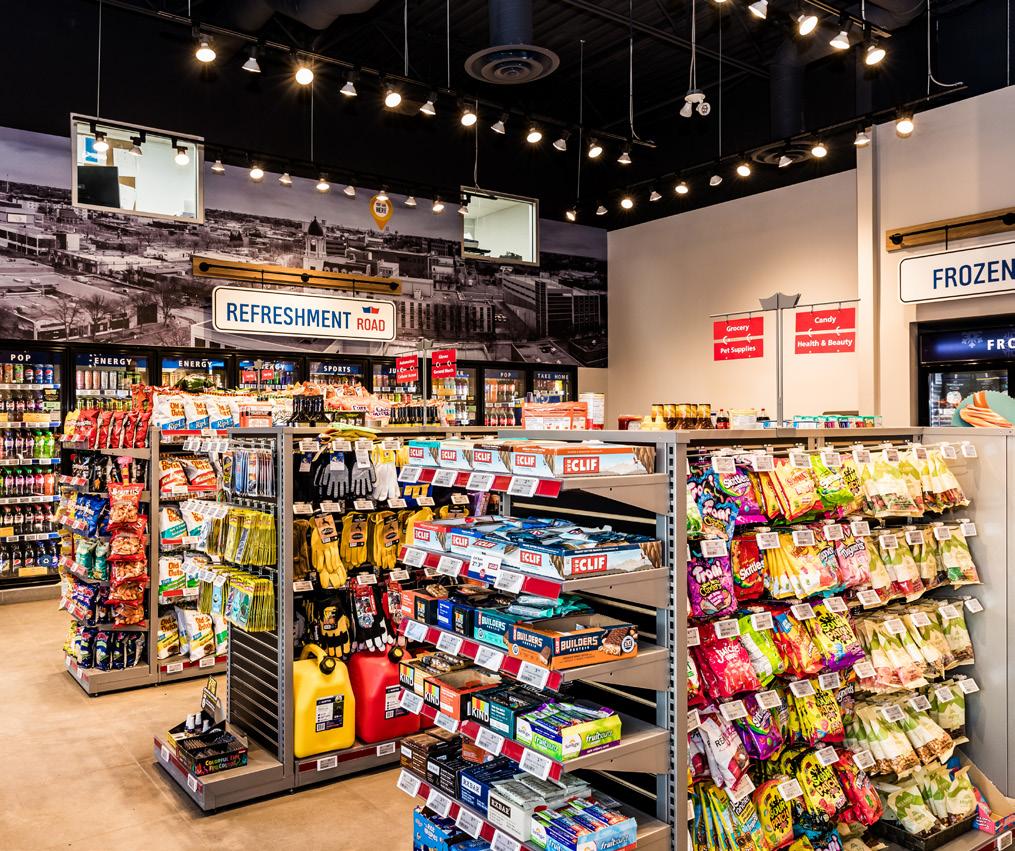
development of its well-stocked convenience stores, which are operated under the company’s SnacKing brand, first introduced at the Lethbridge site in fall 2003.
The interiors of several stores have been redesigned and refitted in recent years–another Lethbridge site in 2004, one 2019 and in spring 2023–with new counters, shelving and walk-in coolers, as well as frozen carbonated beverages machines dispensing Gas King’s own Williwa slush drinks.
Gas King continues to work with CTM Design Services to renovate store interiors: The next one is scheduled to start in 2025. Converting stores to the SnacKing brand involves new ceramic tiles on the floors, paint, lighting and counters, as well as a variety of new store equipment.
After decades of selling a limited number of sandwiches and other ready-to-eat items from an outside supplier, Gas King added its own fresh food to its c-store mix a year ago when it started making, pack-



In addition to new fixtures, retrofits include frozen carbonated beverage machines dispensing
Gas King’s own Williwa slush drinks
wheat farmers in the region, he and his older brother Kevin grew up working in the family business.
In the early 1980s, Don Morris began buying small gas stations to diversify his business. In 1985, a year after he moved back into Lethbridge, Brent partnered with his father in a new retail fuel business that regrouped the nine stations his father owned.
Dubbed Gas King, a name that Brent Morris came up with, the new brand’s first location is its current flagship location—the same store in north-end Lethbridge that was revamped and reopened a year ago with the new kitchen, not to mention a photo and historical plaque dedicated to his father, Don.
“All I knew back then was that I liked marketing more than retail,” says Morris, who now has two children of his own: Zachary, a 21-year-old who has expressed interest in maybe one day taking over the family business, and Alexa, 20, a budding school teacher. “But I worked a lot with my mom doing the accounting, which has really helped me.”
These days, Morris said he is both happy and proud of the look, feel, function and reputation of his business, which employs some 85 people at its seven locations and is actively engaged with its customers and community, both on the ground and online through its website and on social media.
aging and selling homemade foods and snack items—everything from breakfast sandwiches, hot dogs and chicken fingers to deviled eggs, doughnuts and popcorn—in the kitchen of its newly-renovated flagship store near a busy industrial park in north-end Lethbridge.
Dubbed SnacKing Kitchen, the company’s new food label employs a half-dozen people and involves daily deliveries in a van to other Gas King stores.
“The food is fantastic and customer reaction is very positive,” Morris says about the service, which began in February 2023. “But it’s a work in progress. We’re still trying to iron out a few things. Ready-to-eat food is the way our industry is going.”
In addition to its retail offerings, Gas King also plays a prominent role in the communities where its stores operate.
The company is a long-time sponsor of both the Lethbridge Hurricanes major junior team of the Western Hockey League and Lethbridge Bulls summer college baseball team.
Gas King also supports Lethbridge’s Whoop-Up Days, a wildly popular annual summer fair, agri-food exhibition and rodeo, and provides various local charities and cultural and social groups with gift cards for prizes at fundraising events.
Those community contributions, together with the quality of its retail operations, have not gone unnoticed in Southern Alberta, where Gas King has been a perennial winner of annual ‘Best of the Best’ regional business awards over the past 25 years.
“It’s nice to be recognized for the efforts we make,” says Morris. “We’ve always been a good corporate citizen that’s involved in local stuff. And we try to look and act like the majors so that people will drive that extra mile to do business with us.
“Like in any business, success comes from working hard, treating people right and keeping up with the times and the competition.”
Morris, who turned 60 in April, learned those lessons early in life. Born in Lethbridge, but raised in the nearby village of Shaughnessy, where his parents, Don and Georgina Morris, owned and operated a bulk fuel business that hauled diesel and gas to the many cattle and
“We’re focussed on our plans to continue renovating our current locations,” says Morris. Notably, those plans don’t include EV charging for electric cars—at least not yet.
“There’s not much demand for it so far in Lethbridge or Southern Alberta,” says Morris. “But it’s on our radar. If things change, we’ll be sure to look at it closely. We’ve done well knowing what our customers want and offering one-stop services. That approach won’t change.”










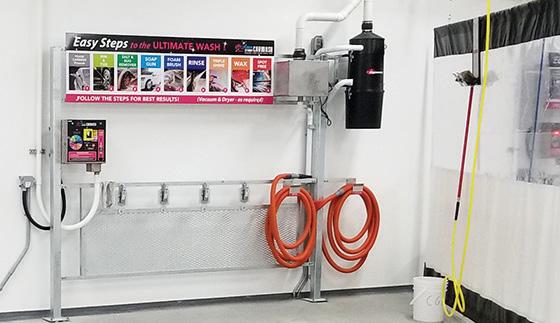
Invest in new soaps and coatings to bring an added sparkle to cars and your bottom line | BY TOM VENETIS
Successful car wash operators focus on creating awareness and branding the car wash experience for customers.
Some of this focuses on the ‘aesthetics’ of the car wash experience, from the actual physical location of the operations— design of the buildings and vacuum areas, interior and exterior lighting and signage—to fun bells and whistles, such as music, coloured foam etc. However, another key component is investing in advanced car wash chemistries to improve the overall wash of a vehicle.
“There is the visual element, such as seeing that a thick foam is being used on your car…as well the special cleaning solutions you asked for…and in the last while we have been getting into using multiple-step cleaning processes [a change] from the traditional two-step processes,” says Tim Walker, president and co-founder of Hamilton, Ont.-based Soapy Brushy, a consultancy and brand strategy provider for the car wash industry in Canada.
Because at the end of the day, what you are providing to vehicle owners (and what it is they want to see) is a clean, dry and shiny car.
Larry Azevedo, chemical field operations manager at Mark VII Equipment Inc., a provider of car wash solutions and chemicals in North America, says a regular car wash routine is vital to maintaining a
Rob Raskell, director of national sales with Sonny’s Chemistry by Diamond Shine, says the trend today with cleaner and treatments has been to concentrate them more so they perform better. In turn, car wash operators are able to charge a bit more for a wash, as they can position these better products as an added value to the vehicle owner.
“There are a lot of extra services you can add onto a wash to add value for the vehicle owner who comes to you,” Raskell says. “While we talk a lot about the cleaning side, we should also remember the second part of the wash experience and that is the shine and drying.”
For a while, waxes were all the rage in the car wash industry, then there came a shift to ceramics, which, according to Raskell, proved a step-up from traditional waxes.
Ceramics caught everyone's attention, as they added an extra layer of protection to a vehicle’s exterior, protecting against the effects of oxygen, water, acids, bases, and salts—all those things that over time tend to take away the shine and finish of a vehicle. Another benefit of ceramic is they are highly hydrophobic, meaning that they are great at repelling water. So, when a car comes out at the end of a wash, any remaining water will bead on the surface and slide right off, adding to the effect of an ultra-clean car with a quality finish.

to the vehicle’s surface.
Kelly Maria, vice-president of chemical and service operations for North American with Mark VII, says that when its graphene infused GraphiteGuard is paired with ShineTecs, the combination creates layer of protection that fills in micro-scratches on a vehicle and gives a vehicle a real shine that lasts longer than other conven tional treatments.
“When I add that to my car and take it home, I get people coming to me and saying how much they like the shine on my car and ask where I got it done,” she says. “When I have the car at home in the garage and open the garage door and look at my car as the sun is coming up, I’m just ‘Wow. This really makes a difference.’”
And it is that difference that will make the upsell to a more premium wash using these newer cleaners and treatments easier for the car wash operation. As Michael Howe, general manager with Wash Links, says, you need to offer something more to justify a higher price, especially as car wash operations are often raising their wash rates to cover the increasing costs of running the operations (not to mention the price increases on everything due to inflation).
“You are concerned that if you increase your prices, you are going to drive a customer away, who are going to say they can no longer afford to wash their car,” Howe explains. “So as a car wash owner, you are looking for products to add to your mix that you can justify saying to that customer, ‘I’m giving you a better value. I can give you a cleaner car. I’m going to make it ‘pop.’ I’m going to give you a better cleaning package for a little bit more.’ The customer does not want to feel they are being slighted or gouged. So, these new products make an upsell easier.”



















• Full cycle inventory management
• Loyalty and gift card options
• Wayne and Gilbarco Pay @ Pump
• Contactless payment options
• Fleet card management and control
• 24/7 Support
• Customized solutions available
• And much more
We also have solutions for unattended fuel sites, First Nation retailers, marina and aviation operators.
888-925-8125 | www.infonet-tech.com

Aquadetox North America
Calgary Coop
Crosstown Car Wash
Davies Car Wash Ltd.
Neelam car Wash Inc.
Ready for Car Wash Inc
Sandstone Center Truck Wash and Storage
Total Web Solutions Inc.
Air-Serv Canada
Aquashine Car Wash
Associated Industrial Brush Co. Ltd.
Auto Spa 2008 / OB Oil Gard
Belvedere Technical Services Ltd
Dickinson Appliance Ltd / Washland
Grand Valley Car Wash
Independent Wash Services Ltd.
Maritime Car Wash
MarkVII Equipment
Matt's Car Wash Ltd.
Mondo Products Co. Ltd.
Parkland Corporation
Pumps & Pressure Inc.
Red Hill Car Wash Inc
Shell Canada Limited
Suncor Energy Inc.
Transchem Group
Valet Car Wash

The Canadian Carwash Association's Golf and Euchre Tournament at Royal Ontario Golf Club on June 13, 2024, promises to be a delightful blend of sporting prowess and social camaraderie.
Golf enthusiasts and card players alike will gather amidst the lush greens of Royal Ontario Golf Club for a day filled with friendly competition and networking opportunities.
Participants can showcase their skills on the golf course or engage in a spirited game of Euchre, fostering bonds within the carwash industry community. With stunning views, exciting contests, and a chance to support a thriving industry association, this event offers a perfect combination of recreation and business engagement.
Location: Royal Ontario Golf Club, Milton, Ontario
Date: Thursday, June 13, 2024
Golf Fees
Foursome - $800 plus tax
Twosome - $400 plus tax
Single - Member - $210/person plus tax
Single - Non-Member/person - $260 plus tax
Euchre Fees
Foursome - $300 plus tax
Single - $75/person plus tax
www.canadiancarwash.ca/Annual-Golf-Tournament-2024




Accelerating our partners forward with JTI DRIVE!
Welcome to JTI DRIVE, JTI’s digital platform designed with our partner’s growth in mind! Build your sales knowledge with engaging Brand videos and comprehensive Product Guides. Use some of the interactive Business Tools created to help accelerate and DRIVE our partners forward! The more you explore, the more points you can earn to redeem valuable rewards.

Scan QR code to automatically be awarded 250 JTI DRIVE Points:
*QR code valid for one-time redemption by eligible JTI DRIVE trade members. Product information for the exclusive use of retailers.
People first: As Jessica Friesen marks 10 years at the helm of Gale’s, she shares her vision for creating an inclusive business that staff and customers are proud to support

than milk: Today’s c-stores are a destination for an ever-increasing assortment of innovative dairy products that cater
Frozen assets: From ice cream novelties to freezies, innovation and premiumization are giving the category a new cool. Insiders share strategies for boosting sales

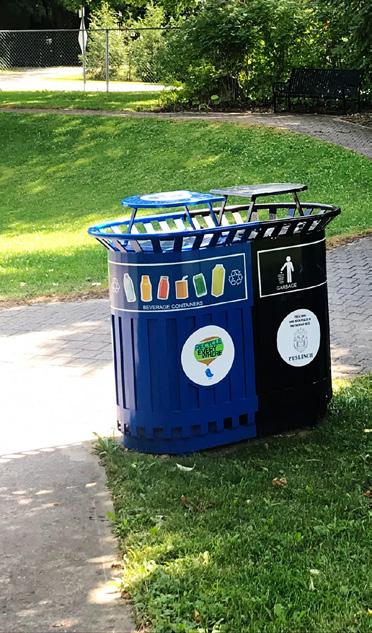
Make a shift: Stop the Shift Show author and former franchise owner, Scott Greenberg, shares his insights on how to retain hourlyworkers and create winning teams
Comprised of



WELCOME TO THE spring issue, which has a dual focus—people and the planet. Both are fundamental to the success and longevity of the channel. Afterall, a company’s sustainability efforts can affect employee recruitment and retention: People want to work for companies where they feel valued and with which they share values.
With that in mind, we are thrilled to bring you several inspiring, actionable and thought-provoking articles about supporting staff and sustainability efforts.
Ever since hearing about Jessica Friesen’s LGBTQ2S+ advocacy in action, I have wanted to hear more about what makes Gale’s Gas Bars a beacon of best practices for hiring and retention. You might be shocked to hear that just 35% of LGBTQ professionals feel safe being their authentic selves at work, according to a 2023 report from LinkedIn. Turn to p. 12 to find out how Friesen is changing the narrative by standing up to haters as part of her efforts to create a safe and caring workplace for staff (and customers).
Plus, we talk to Stop the Shift Show author Scott Greenberg, who shares strategies for retaining hourly workers and creating winning teams (p. 36).
On that note, keep in mind that more than 70% of workers and those looking for work are drawn to environmentally sustainable employers, according to Sustainability at a Turning Point, a report from the IBM Institute for Business Value.
Customers are also taking note. The 2024 C-store IQ Sustainability Report supports this, with two-thirds of c-store shoppers in Canada saying they would consider switching stores based on sustainability efforts. Find out what this means for your business (p. 34). Plus, we look at efforts, innovations and partnerships happening in the c-store sector, from store operations to product packaging and more (p. 18).
Showcasing why this is an inspiring channel in which to work is an important part of what we do as your industry magazine. With that in mind, it’s time to celebrate your good-news efforts with the 2024 CSNC Impact Awards. Now in its third year, the program recognizes initiatives introduced by retailers, suppliers, distributors and solution providers that are making a meaningful difference in a range of areas, from the environment to supporting employees and communities. The deadline to nominate is May 31st and winners will be featured in the September/October issue, as well as via a digital campaign.
We are always honoured to share your success stories and look forward to hearing how your business is #MakingAnImpact!
P.S. Due to popular demand, tickets for the 2024 Star Women in Convenience event are on sale now. Winners will be announced June 27th and celebrated at the in-person event October 1st. CSNC

 MICHELLE WARREN Editor & associate publisher
MICHELLE WARREN Editor & associate publisher
20 Eglinton Ave. West, Suite 1800, Toronto, ON M4R 1K8 416-256-9908 | (877) 687-7321 | Fax (888) 889-9522 www.CCentral.ca
BRAND MANAGEMENT
SENIOR VICE PRESIDENT, GROCERY AND CONVENIENCE, CANADA Sandra Parente 416-271-4706 sparente@ensembleiq.com
EDITORIAL
EDITOR & ASSOCIATE PUBLISHER Michelle Warren mwarren@ensembleiq.com
ASSOCIATE EDITOR Tom Venetis tvenetis@ensembleiq.com
ADVERTISING SALES AND BUSINESS
SALES DIRECTOR Julia Sokolova 647-407-8236 rthomson@ensembleiq.com
NATIONAL ACCOUNT MANAGER
Roberta Thomson 416-843-5534 rthomson@ensembleiq.com
ACCOUNT MANAGER Holly Power 416-910-1085 hpower@ensembleiq.com
SALES COORDINATOR Juan Chacon jchacon@ensembleiq.com
DESIGN | PRODUCTION | MARKETING CREATIVE DIRECTOR Nancy Peterman npeterman@ensembleiq.com
ART DIRECTOR Jackie Shipley jshipley@ensembleiq.com
SENIOR PRODUCTION DIRECTOR Michael Kimpton mkimpton@ensembleiq.com
MARKETING MANAGER Jakob Wodnicki jwodnicki@ensembleiq.com
CORPORATE OFFICERS
CHIEF EXECUTIVE OFFICER Jennifer Litterick
CHIEF FINANCIAL OFFICER Jane Volland
CHIEF OPERATING OFFICER Derek Estey
CHIEF PEOPLE OFFICER Ann Jadown
CHIEF STRATEGY OFFICER Joe Territo
SUBSCRIPTION SERVICES
Subscription Questions contactus@ccentral.ca
Subscriptions: Print $78.00 per year, 2 year $144.00, Digital $45.00 per year, 2 year $84.00, Outside Canada $120.00 per year, Single copy $14.40,
$19.20. Email: csnc@ccentral.ca
Phone: 1-877-687-7321, between 9 a.m. to 5 p.m. EST weekdays Fax: 1-888-520-3608 | Online: www.ccentral.ca/subscribe
Convenience Store News Canada | Octane is published 6 times a year by Ensembleiq. Convenience Store News Canada | Octane is circulated to managers, buyers and professionals working in Canada’s convenience, gas and wash channel. Please direct inquiries to the editorial offices. Contributions of articles, photographs and industry information are welcome, but cannot be acknowledged or returned. ©2024 All rights reserved. No part of this publication may be reproduced in any form, including photocopying and electronic retrieval/retransmission, without the permission of the publisher. Printed in Canada by Transcontinental Printing | PM42940023
CHANNEL ALLIANCES:


Roberta Thomson joins Ensemble IQ as full-time national account manager, working on print and digital sales solutions for Convenience Store News Canada + OCTANE, All Convenience Newsletter, Star Women in Convenience, FLICC, CSNC Impact Awards, The Convenience U CARWACS Show and related brands/events. She can be reached at rthomson@ensembleiq.com In Canada, the convenience channel generates $ 5 4 BILLION IN SALES collecting $ 26 BILLION IN TAXES for various levels of government

Ontario's minimum wage will jump to $17.20 an hour on October 1, from $16.55. It will be the second highest of the provinces, behind British Columbia's $17.40 per hour.

Congratulations to the inaugural Future Leaders in Convenience + Car Wash winners, who were celebrated at The Convenience U CARWACS Show in March. Nominations open September 5th.








Derin Bello is promoted to general manager in Canada at Mars Food & Nutrition. She previously served as vice-president of sales at Mars Wrigley Canada
Shawna Bickford is now senior sales manager at Now Prepay. The 2023 Star Women in Convenience winner has been with the company 16 years.
Jason Blake is promoted to president at PepsiCo Beverages Canada. Blake joined the company more than 16 years ago and has held several roles across food and beverages, most recently as SVP, commercial for PBNA South Division.
Chantalle Butler took over as president of the Molson Coors Beverage Company business in Canada on April 2. The former vice-president of sales finance joined the company five years ago. She also serves as chair of The Beer Store (TBS).
Kent Ferguson takes on the role of SVP, strategy, sustainability and corporate development at Suncor He brings over 25 years of energy industry experience to the role, including an extensive understanding of the Canadian market.
Former Prime Minister Stephen J. Harper joins the Board of Directors for Alimentation Couche-Tard. Harper is chairman and CEO of Harper & Associates Consulting.
Scott McPherson is promoted to executive vice-president and chief field operations officer at Performance Food Group (PFG). During his 30-year career, he has held numerous leadership positions with Core-Mark
How can AI surveillance modernize inventory management for c-stores?
Imperial Tobacco Canada launches education campaign around nicotine pouches
Now is the time for expanded packaged beverage alcohol retailing in the Maritimes: CICC

Parkland announces sale of 157 c-stores with gas in Canada
Canco Petroleum opens new location in Ontario
KaleMart24 opens fresh convenience concept in Montreal
Petro-Canada and Canadian Tire launch loyalty partnership

Q&A: Conagra Brand ’s Michael Fazio talks sustainability
enters partnership with Shell Canada
Robin Poulain joins Conagra Brands Canada as group director, sales, Sobeys. The 2020 SWIC winner brings more than 15 years of customer leadership experience to the role, most recently with Kind.
Accelerate Program to help c-stores host ultrafast EV Chargers Don’t miss the latest news and trends, get the All Convenience e-newsletter delivered to your in-box Monday + Wednesday. Sign up at CCentral.ca/newsletter



The monthly New on Shelf e-newsletter features products carefully selected by our editors, as well as sponsored product placement.
From confection to snacks, beverages and more, we’re spotlighting product innovation.
Sponsored products will:
• be featured in our New on Shelf enewsletter – you choose the date
• live on ccentral.ca- so retailers have access 24/7
• be promoted through brand social channels
Specifications
• 1 product shot (655 x 368, 1MB, JPG file)
• 1 product write-up (50-75 words)
• Click-through URL featuring the product


The Path to Purchase Institute brought its popular Retail Media Summit to Canada. Retailers, brand marketers and solution providers gathered on Feb. 6 at the Toronto Congress Centre to unpack the retail media challenges and opportunities unique to Canada as well as across the globe.
Topics and themes from P2PI’s inaugural Retail Media Summit Canada ranged from the importance of closed-loop measurement and an omnichannel approach, to organizational mapping and enhancing a shopper’s experience across the path to purchase. Read on for highlights from the day.
T he numbers surrounding retail media’s growing influence and power in the marketing industry are usually huge across the globe, and it’s no different in Canada. Retail media ad spend is expected to reach $5 billion by 2027 (a huge jump from $2 billion in 2022) and, in fewer than three years, will double the ad spend of traditional TV.
“This is no longer an emerging media format. [Retail media] is here,” said Jeremy Vianna, vice-president and general manager, audience and ad products, Advance powered by Loblaw, noting retail media will account for one in five digital ad dollars spent in Canada this year. “It’s not in the startup phase anymore. It’s a trusted part of a marketer’s playbook.”
In his session, Vianna urged attendees to consider a few key practices and trends to inform and advance their retail media strategies and campaigns. Among them, Vianna suggested taking into consideration both the e-commerce shopper journey (opening email, browsing deals in a digital circular, checking out online, etc.) as well as the in-store purchase journey (hearing or seeing an in-store ad, etc.). Analyzing campaigns run though the retailer, Vianna said advertisers that are layering tactics across different modalities (onsite and offsite) are seeing major lift in their conversion success (versus those activating offsite media alone).
“People move in and out of different buying behaviours,” he said. “When you think about the myriad and drastic increase in marketing touchpoints that you have available, you have to have a plan to be able to address all these things. The idea is not to think about the physical journey or the digital journey as an ‘or’ but to think of them as an ‘and.’”
In addition, Vianna spoke about three key measurement requirements:
• Credible. We don’t want RMNs grading their own homework. Thirdparty verified data is foundational to building trust.
• Scalable. Lack of measurement standardization hurts scale. Simple
JeremyVianna,
vice-president and general manager, audience and ad products, Advance poweredby Loblaw

metric definitions and consistency across networks will allow marketers to speak the same language, Vianna said.
• Actionable. Moving from purchase attribution to telling the story of incremental sales.
Retail media is akin to a very high-level sport, said Claire Wyatt, who worked at retail media network Roundel and now is VP of business strategy and marketing science with Albertsons Media Collective. “It feels like you have to show up every day and be very aggressive [and] you kind of fall a lot."
If you examine retail media’s emergence and evolution over the years, the first wave of retail media in the U.S. began with a focus on monetizing a retailer’s own digital properties (solutions like onsite search and display) and driving gross margin. “Retail media 2.0” was a pivot to retailers operating more like a media publisher.
“Retail media 3.0 is a complete integration of the entire business that perpetuates the flywheel of retail media,” Wyatt said. “It is ... [about] how do
you gather as much data about your customers, in a very privacy-focused way, as quickly as possible, and then use that data to then monetize what we now call retail media—but my expectation is, in the future, it’ll be something different and something even more data-centric.”
Wyatt highlights how retail media is not just a media channel, but also a layer that supports other channels. First-party data from RMNs can be leveraged for targeting and attribution on digital ad channels such as Roku, Facebook and Google. “When we talk about spend shifting into retail media, it is somewhat shifting to retail media from other channels, but it is actually really a different way to activate those channels,” Wyatt explained, adding the value proposition of a retail media network is closed-loop measurement and audience data. For measurement, there are three key considerations:
• Closed-loop measurement. The importance of being able to tie the advertising (inclusive of online and in-store) to a sale. (If this is an issue, Wyatt advised leveraging third-party partners for help.)
• Incrementality. Incremental return on ad spend (ROAS) showcases the true impact of media. There are various methodologies to incrementality measurement but, the most important is not which is employed, but rather an RMN’s transparency with its clients, Wyatt said.
• KPIs tied to objective. As retail media moves up the funnel, it’s important to add more KPIs than just ROAS. KPIs like “new customer” or “customer lifetime value” will become more popular.
The shopper experience needs to be top priority, according to Chris Riegel, CEO of Stratacache, a global in-store retail media, digital signage and advanced sensor solution provider. “We walk into retailers around the globe all the time [asking,] what are you trying to accomplish? ‘I want more money.’ Cool. Wrong, but cool. How are you going to improve that customer’s journey ... should be the question.Improve her experience in-store. Help her achieve that strategic goal and give her a reason to come back to your store more frequently to have a better experience.”
Riegel highlighted a few solutions and examples to engage with shoppers in-store, including entryway kiosks displaying a touch-enabled circular and custom promotional content, and digital, interactive fixtures that offer product comparison, selection, and education similar to an e-commerce site.
“I ask retailers all the time, ‘Who is your competition when you’re selling a shopper marketing network?’ It’s not Loblaws competing with Sobeys or Kroger competing with Walmart competing with Target. You’re competing with TikTok, you’re competing with Meta, you’re competing with Google,” Riegel said. “The difference is you have the shopper in your store and you have the product on your shelf and the ability to convert that sale. They do not.”
Additionally, Riegel emphasized having digital screens in-store is simply not enough and a measurement infrastructure needs to be in place from the start. He also encouraged executives to start having dialogues with their loyalty and shopper insights teams to implement a streaming/CTV strategy.
• Embrace customers as audiences in store and at home.
• In-store media networks onsite and CTV offsite can open new paths to high-margin revenue that can significantly impact a company’s bottom line.
• All uses of media should enhance a shopper’s experience.
There’s no question that retail media has become the media darling. Sharing results from a Canada Retail Media 2024 study eMarketer produced in conjunction with the IAB Canada, Sonia Carreno, IAB Canada president, highlighted a few insights about the Canadian retail media landscape:
• Search will account for 65% of retail media ad spend this year.
• 35% of retail media ad spend will be directed to display and video in 2024. As part of the study, the top media buyers in Canada were also asked what the most important attributes are when buying ads in retail media. “Traffic quality” was cited as the most important attribute, Carreno said. “I suspect that Canadians are looking at this from a lower formal opportunity lens."
Among the opportunities and challenges within the Canadian market:
• Conservative attachment to lower-funnel performance advertising.
• First-party data jitters with new regulations in Quebec requiring consents and more rules to come.
• Tech stack limitations (self-serve platforms are coming, Carreno said, but not at the speed and scale of the U.S.).
From organization mapping to emerging trends and strategies in the space, executives from Threefold, Keurig Dr Pepper and Google Canada shared their insights and positions on a variety of topics for a panel discussion examining the current retail media landscape in the U.S., Canada and across the globe.
Considering retail media’s definition, Richard Rodgers, Keurig Dr Pepper Canada’s marketing director – Keurig, said he approaches it as an enabler for a seamless omnichannel experience, allowing for personalized consumer experiences when they’re in the shopping mindset. Building on Rodgers’ comments, Sean Crawford, managing director, North America, Threefold, emphasized the shopper is (or at least should be) at the heart of retail media.
“Retail media is not ad sales,” Crawford said. “I think if we put shoppers at the heart of everything that we’re doing, that’s the true definition of retail media. And it’s important that any marketing we do helps, absolutely, enhance their experience — whether that is in store or on [a retailer’s] website.”
As far as organizational mapping, Rodgers shared omnichannel efforts were being pushed internally at his company even before the COVID-19 pandemic, which only accelerated and forced the issue. Traditional shopper marketing and digital shelf teams merged and, most recently, the brand marketing team was brought into the mix (keeping the function separate but under one leadership).
“I think there’s a lot of organizations that are interested in doing that or exploring that,” Rodgers said. “We’re lucky enough to [have taken] that plunge, and it’s been very successful for us and we anticipate other companies will follow.”
Emphasizing the importance of brand presences and engaging shoppers across the path to purchase, John Fanous, head of omnichannel retail, Google Canada, shared that during the course of the 40-minute panel there will be 7,300 searches for shampoo and 3,000 videos viewed on YouTube on how to get lustrous hair. Moreover, he also shared that a third of Canadian consumers are actively seeking out an alternate brand to the one that they are used to buying.
“That means a lot of opportunities. Also, means a lot of risk,” Fanous said. “Retail media’s ability to actually leverage the knowledge of the customer to essentially bring the right message to the right customer has never been more important.”
 Claire Wyatt, vicepresident of business strategy & marketing science, Albertsons Media Collective
Claire Wyatt, vicepresident of business strategy & marketing science, Albertsons Media Collective
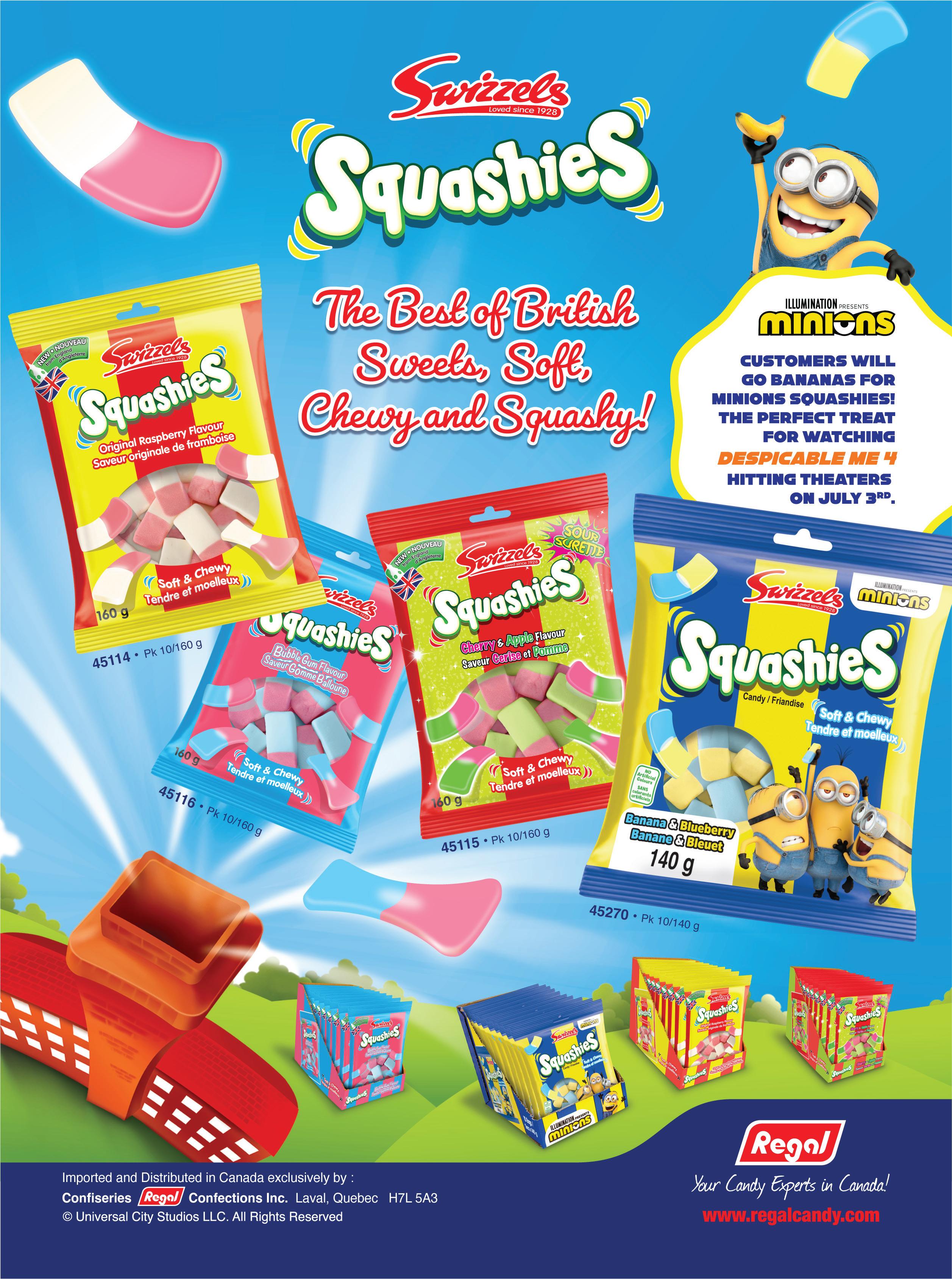
‘It’s not just about my family or the Gale family. It’s the fact that we have generations of employees who have worked for us’
Jessica Friesen
‘I would describe the workplace culture as advanced for a service station’
Kevin Hawerchuck, employee of 44 years
As Jessica Friesen marks 10 years at the helm of Gale’s Gas Bars, she shares her vision for creating an inclusive business that staff and customers are proud to support
BY CHRIS DANIELS | PHOTOGRAPHY BY TOBI ASMOUCHA‘I was raised to always think about others and help where I can’
Jessica Friesen
‘Gale’s has been amazing and supportive of my transition— as well as the entire LGBTQ+ community’
Jessica Jones, employee

Between 75% and 80% of staff have been with the company three years or longer; some employee tenures extend decades
Recently celebrating her third-year work anniversary at Gale’s Gas Bars, Jessica Jones has found a workplace where she is fully supported as a trans woman.
In fact, Gale’s, which operates 11 gas stations, four convenience stores and provides wholesale fuel delivery in Ontario’s Niagara region, hired her when no one else gave her a chance.
“I had sent out literally hundreds of resumes and was upfront about the fact that I was in transition. And Gale’s was one of only two places that responded,” recalls Jones, who wanted to exit trucking, her prior vocation, and now works at one of the company’s Bob’s Fast and Fresh Convenience stores.
And when Jones needed time off for her surgery six months into her employment, Gale’s didn’t bat an eye. “I was off work for a month and a half—and there was no issue,” she recalls. “Gale’s has been amazing and supportive of my transition—as well as the entire LGBTQ+ community.”
Workplace inclusivity—the practice of ensuring every person feels safe and that they belong, regardless of gender identity, sexual orientation, race, background and age—begins at the top. And in third-generation Gale’s owner and operator, Jessica Friesen, the roughly 85-person strong workforce has more than just a boss. They have an advocate.
“I was raised to always think about others and help where I can,” reflects Friesen, whose empathic leadership has cultivated a people-first culture—a big reason Gale’s has been serving Niagara residents for more than 55 years and counting. “We’ve worked diligently to build a workplace culture that is inclusive and supportive—a place where they are proud to work, and that our customers are proud to support.”
The pride is demonstrated in the average employee tenure at Gale’s. Between 75% and 80% of its staff have been with the company three years or longer; some employee tenures extend decades.
Gale’s became the first and only retailer in the petroleum and convenience industry to meet the stringent standards for accreditation by the Rainbow Registration with the 2SLGBTQI+ Chamber of Commerce in 2022




This thrills Friesen. She concedes, however, that “people tell me all the time that my hope for new hires to stay with us until they retire is antiquated.” Maybe so, but the longer employees stay, the more “it means we’re doing something right,” she told CSNC during an interview in her office at the company’s headquarters.
As Friesen discussed her vision, her shy COVID pup, Dozer, a boxer, hid under the desk. Dozer accompanies Friesen to work most days and the team loves having the dog on site.
“We invest in people,” notes Friesen. “We offer both dental and medical benefits to all employees. And we give them a Tim Hortons gift card as a thank you when we’re made aware of a customer compliment extended to them.”
Fostering employer pride with staff is smart, savvy business. Not only does it reduce costs that come with replacing a revolving door of employees, but also high retention translates to customer loyalty for Gale’s. Friesen attributes this to helping the business survive the pandemic. “We are very lucky to have a very solid customer base,” she says. “We have been big supporters of Niagara for over 55 years, and I think that helps. We’ve got people that believe in the family nature of the business, and I say to everybody, ‘It’s not just about my family or the Gale family. It’s the fact that we have generations of employees who have worked for us.’”
Service station attendant Kevin Hawerchuk is a 44-year veteran of Gale’s, and at his previous location with the company, on Ontario Street in St. Catherines, he had built up relations with dozens of customers. “I had many such rapports—people would purposefully come in when I was working to fill their gas, for example,” says Hawerchuk, who is now at a new location developing customer relationships.
Why has he been loyal to Gale’s for all these decades? “I would describe the workplace culture as advanced for a service station,” says Hawerchuk. “Gale’s has treated me very well as an employee.”
The business was started by Friesen’s late grandfather, Robert Gale Sr., when he purchased a gas station in 1967—mostly for the truck wash station attached to it, as he drove a fuel truck for Champion Oil. Her father, Robert Gale Jr., took over Gale’s in the 1980s, expanding the fuel station with the company’s first Bob’s Fast and Fresh Convenience store in 2009.
Having become a registered nurse (she still shares her nursing expertise with volunteer board work), Friesen never imagined she would take over the family business in 2014. But when she suffered postpartum depression after the birth of her son, her father suggested she get out of the house by helping him with two new properties. “He said, ‘Why don’t you talk to some of the suppliers of the convenience store?’ And I fell in love with being able to foster those relationships and make decisions about the business.”
Bob’s Fast and Fresh Convenience stores, which now number four, GALES







have become a critical footprint to the success of the business. “Fuel stations are what bring customers to us, but the margins are better in the stores,” notes Friesen.
For urban dwellers, the stores feel almost like a general store, selling chips and candy, household cleaning supplies, shelf stable foods, fresh groceries like eggs and milk, and even pet food. A self-serve counter features a microwave where customers can heat up a danish or make a cup of coffee.
In addition to the mantra “treat others the way you’d like to be treated,” Friesen was raised to believe “that if you do good, people will talk about it.” And while that may have been true in the past, she says the reverse is now true—“Bad news travels fast”—and has shifted her approach about touting Gale’s more publicly.
“We’ve accepted the fact that if we’re not telling our story, and bringing what makes us different to the forefront, then we run the risk of nobody talking about us,” she says. “And so, I started looking at things that would allow us to tell what’s great about Gale’s without being too ostentatious.”
For instance, the company became the first and only retailer in the petroleum and convenience industry to meet the stringent standards for accreditation by the Rainbow Registration with the 2SLGBTQI+ Chamber of Commerce in 2022. “We have several trans and gay staff members,” says Friesen.
Pride flags hang prominently in the convenience store windows, a symbol that the business meets standards to ensure 2SLGBTQI+ customers and employees feel safe, welcomed, and accepted.
“Being a smaller business, and as an owner who is boots to the ground, I can look at these designations, research them and work to obtain the designations, if I think it’s something that’s feasible,” says Friesen. “Oftentimes, we’re already meeting a lot of the criteria outlined by these designations.”
The only change Gale’s made to earn its Rainbow Registration, for instance, “was making the male bathroom and female bathroom unisex bathrooms.”
While showing a visible symbol of support is important, Friesen also uses her position and privilege to speak out against discrimination and harassment, while simultaneously promoting empathy and inclusion.
In 2022, Friesen spoke out after a customer hurled homophobic slurs and threw candy at an employee. Her efforts included a blog post on the writing platform Medium, where she has almost 1,000 followers and has blogged about everything from being a business owner to her weight fluctuations over the years.
“He’s a young man [and] deserves to live without fear. We all do,” she wrote. “So, what can be done. I’m about to get louder. We all should.”
Gale’s shared the video of the disturbing incident on Facebook when speaking out about it with Niagara 411 news, which has 138,000 followers, and its own Facebook page, where the video has been viewed 1,600 times.
And when a minority of customers started taking out their frustrations about high fuel costs on staff, including verbal abuse, Friesen piped up again. “It is NOT OK for our employees to face abuse, harassment, hate talk, etc., because of the price of gas,” she wrote. And to one past customer in particular who used expletives, she told this individual “please don’t come back.”
Friesen—who also published in 2021 a first-hand account of prioritizing her mental health following her post-partum with the book "This Will Not Break Me: My Personal Journey with Postpartum Depression"—says speaking out is the least she can do. “It’s important for me to break that glass wall as a business owner. Because while my decisions as the boss may impact more people, you know what? At the end of the day, it’s the people at the pumps and counters that are really bringing in our income.”

Gale’s Gas Bars has 11 active sites—seven with a full-service offering, either completely full serve or split serve.
“It’s important to keep an eye on your customer demographics and cater to them. Niagara still has a great demand for full serve—whether that be because of the older demographic, the commuters going to the GTA, or some other reason, we know our customers still want it.”
Gale’s isn’t rushing to add electric vehicle chargers—yet. We don’t see those vehicles very much here,” says Friesen. “But we’re keeping an eye on it.”
Having a diverse workplace starts with creating a place where people feel comfortable and safe.
“We recognize that employees are not just here for a pay cheque. We have worked diligently to build a workplace culture that is inclusive and supportive—a place where they are proud to work, and that our customers are proud to support,” says Friesen. CSNC

Your industry is filled with companies making a positive impact and it’s time to shine a light on those efforts!
The Convenience Stores News Canada Impact Awards will recognize initiatives introduced by retailers, suppliers and solution providers that are making a meaningful difference, from helping the planet to supporting employees and communities.
The goal is to celebrate companies—large or small—making a positive impact across four key areas:
• Sustainability (initiatives around food waste, ethical sourcing, energy efficiency etc.)
• Diversity, Equity & Inclusion
• Supporting Employees
• Community Service/Local Impact/Giving Back
There is no fee to nominate (you can even nominate in multiple categories), and honourees will be featured in Convenience Store News Canada magazine and online this fall.
Tell the industry about the amazing work being done at your company!





How are c-stores and their suppliers showing up for the planet? It’s a critical question for the sustainability of the world’s resources, as well as for addressing the global climate crisis. But the question goes beyond an ESG framework. At a granular level, it is about empowering consumers to make better choices about where they shop and what they buy, so that they can live sustainable lifestyles and contribute to the health of the planet.
According to Kantar’s Sustainability Sector Index, 79% of Canadians want to live a sustainable lifestyle. The reality, however, is only 21% are actively changing their behaviour.

“The gap between what consumers value and how they behave, referred to as the value-action gap at Kantar, can be closed over time; however, it does require intentional efforts by brands to make sustainable habit building easier and more valuable in the lives of consumers,” says Margaret McKellar, senior vice-president, client partner at Kantar North America, who recently completed the Cambridge Institute for Sustainability Leadership Program.
In fact, she says consumers expect “intentional efforts” now, so much so that their perception of brands “is highly influenced by how they show up in the sustainability space. This evolving market dynamic has prompted an adjustment in corporate ESG strategy from ‘do less harm’ to ‘do more good.’”
Work is underway by c-stores and their suppliers to help consumers adopt sustainable shopping habits. This report looks at the transitions, innovations and partnerships happening in the c-store sector, from store operations to product packaging.
When it comes to being a smooth operator in retail today, it is all about having a gentle footprint on the environment. Here, three c-store chains share with Convenience Store News Canada how they’re prioritizing sustainability in their operations.

The independent chain, which has 36 locations in the GTA, has installed solar panels across its distribution centres, a move “expected to offset nearly all of the electricity we use annually,” says Rima Rabba, director of marketing at the family-owned company. “This significant investment substantially reduces our reliance on non-renewable energy sources and reduces our carbon footprint.” The chain has also made changes to in-store packaging to limit single-use plastics on beverages, snacks and other items, and prioritize “sourcing products that are both reusable and recyclable, aligning with our goal to minimize environmental impact.” Adds Rabba: “By expanding our selection of environmentally friendly brands, we aim to empower customers to make more sustainable choices without compromising convenience or quality.” It

has also forged partnerships with the likes of Darling Ingredients, an Irving, Texas-based company that repurposes and recycles materials from the animal agriculture and food industries. As part of its program with Darling, used cooking oil and animal fats at Rabba Fine Foods are being collected and repurposed to produce renewable, cleaner diesel, allowing the company to “help the environment by using something that would otherwise be considered negligible.” Rabba Fine Foods also collaborates with Second Harvest to reduce food waste. The chain uses various channels, including its website, social media platforms and in-store signage, to inform customers about its sustainability initiatives, and engages them through community events and outreach programs. “Environmental stewardship is increasingly important to our customers when choosing where to shop,” says Rabba. “They appreciate knowing that their purchases support an independent retailer that prioritizes sustainability and actively works to reduce its environmental footprint.”

The way c-store entrepreneur Sam Saoudi looks at it, it’s disingenuous in one breath to say that you provide healthier choices at convenience to customers, but then not have a store that operationally walks the talk. “Sustainability aligns with the values of health and well-being, extending beyond just the products offered to the entire ethos of the company,” explains Saoudi. “By prioritizing eco-friendly practices, KaleMart24 not only enhances its appeal to environmentally conscious customers, but also contributes positively to the planet's health, fostering a more sustainable future for all.” The first KaleMart24 opened in March in the BERRI-UQAM Metro station in Montreal, and its commitment to “urban sustainability“ was on full display. The 1,400-sq.-ft. store features LED lighting throughout; energy-efficient HVAC systems; sustainable materials, including eco-friendly building materials and furnishings, such as recycled or reclaimed wood and steels; and low-VOC paints (VOCs stands for Volatile Organic Compounds, which can pollute the air); and a recycling program which encourages customers to bring reusable coffee cups to reduce the amount of waste generated by the store. Like Rabba, KaleMart24, which
recently opened a second store in Montreal’s Jarry Metro station and has shared plans to have five locations running by the end of the year, is prioritizing suppliers that align with its commitment to healthier choices and environment sustainability. “We seek brands with sustainable sourcing, eco-friendly packaging and ethical standards. Local sourcing and transparency in practices are also emphasized,” says Saoudi, who is also CEO of Toro Beverages, a brand of sugar-free matcha-based energy beverages. “This approach ensures that KaleMart24's offerings reflect its values while minimizing environmental impact.”

Maureen Pellettier boasts an impressive work history in energy efficiency and decarbonization initiatives for several companies, including Suncor. Since joining Parkland in early 2023 as project manager, environmental, social and governance, Pellettier has built a strategic plan for the Calgary-based retail and energy company to meet its sustainability goals of reducing its Scope 1 and 2 GHG emissions by 40% per site by 2030. “Our strategy has three pillars: energy efficiency, electrification and decarbonization, and renewables,” she says. On the first pillar, Parkland is working on implementing a formal energy management system, which will include performance monitoring capabilities related to HVAC. One company it has partnered with uses AI sensors and controls to help improve HVAC performance. An invoice data management project will also help to bring clarity to Parkland’s energy usage. “We have more than 100 utility providers that are servicing us in Canada,” notes Pelletier. “Once we formalize those two projects [energy management system and invoice data management], we can start to work in areas like demand energy response and time of use as part of our progression towards overall performance management. The amount of work we can do with better data will be incredible.”
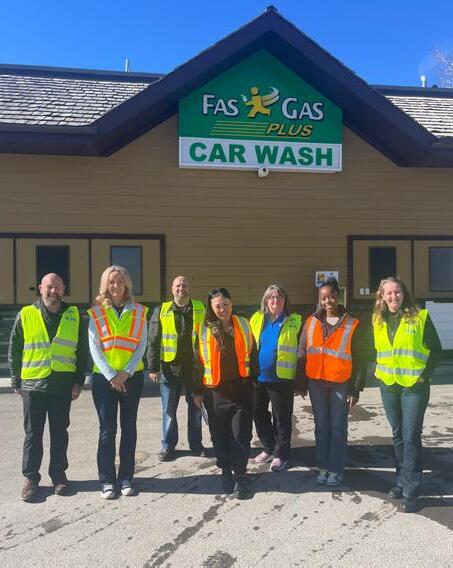
At On the Run stores, Parkland is looking at electrifying hot water tanks and boilers, either fully or with a hybrid solution, and as part of decarbonization efforts, has started a unique trial with its car wash operations. “Even at a very commercial retail level, there are carbon capture technology to investigate,” she says. On the Run with gas stations also ran a successful pilot with EcoTank (see sidebar). Pellettier stresses the importance of the Parkland Facilities Infrastructure team who handles and leads the maintenance activities of the store. “Parkland is embracing the Drive to Zero in terms of energy and water consumption, emissions and waste. It is a journey to continue to build a sustained energy management program, and in particular it is a team’s input and support as the foundation to the success of our Parkland journey in sustainability.”
Parkland diverted 12,619 plastic jugs from landfills across 14 locations in 2023 as part of a pilot program with EcoTank Canada, which manufactures windshield washer fluid dispensers that release fluid by the litre directly into a vehicle similar to a fuel pump.
At press time, there were 309 EcoTanks nationwide, with the largest customers of the solution being Sobeys, Irving Oil, PetroCanada, Parkland and Canadian Tire.

“The EcoTanks are an amenity and drive traffic to the store and that increases other product sales,” says Robbie Mair, EcoTank Canada’s co-founder and CEO. “Combine that with the cost savings of handling, taking up space, stolen inventory, and additional disposal costs of the jugs, there is an overall economical benefit to the operator.”
Its modeling also shows increases of 10% to 20% in overall volume sold of windshield washer fluid per year, versus if a gas station only sells fluid in jugs.
To set up the dispensers, EcoTank charges retailers a small installation fee and then a revenue-sharing model is signed. “We enter into a long-term operating agreement, and they get a percentage of the revenue for effectively letting us put the units on their site,” says Mair. “We manage and service completely hands-free for the operator.”
He says EcoTank Canada has reduced over 100,000 jugs since its official launch with a 7-Eleven store in Orangeville, Ont. in early 2022, and has reduced 36,000 jugs over the last two months.
An average store reduces about 2,000 plastic jugs from landfills over a year, adds Mair.
Frances_Third_AD_04.11.2024.pdf 1 4/11/24 11:57 AM
Manufacturers in the refrigerator section have been making packaging innovation announcements over the past six months.
In North America, Flow Beverage will debut this summer a new brand platform and updated packaging for Flow Original followed by Flavoured Water later in the year. The new packaging will make Flow the most sustainable Tetra Pak package, with more than 80% renewable materials (including, for the first time, post-consumer recycled content). The carton will also be sealed with an improved sugarcane-based cap. Flow's new package is also designed to have the lowest carbon footprint to date; seven times lower than glass, four times lower than aluminum, and three times lower than PET.
BlueTriton Brands Canada, whose portfolio include Pure Life and Ac+ion Water, has set a goal for all its bottles to be recycled and recaptured for reuse.

Currently, over 70% of BlueTriton products sold in c-stores are 100% recycled PET, says Scott McIntyre, VP and general manager, BlueTriton Brands Canada.
To lead on the collection and recapture, McIntyre says BlueTriton “continues to work with provinces across Canada through the current transition to more producer responsibility for blue box and deposit-return programs,” including through public spaces recycling pilot projects.
All of Coca-Cola’s 500 ml bottles—except for the cap and label—are now made entirely out of recycled (PET) plastic. The rollout started in early 2024 and makes the soft drink giant the first company to launch multiple sparkling beverages in 100% recycled plastic bottles across Canada. (See Q&A with Coca-Cola Canada’s Mika Unterman p. 22).

 Robbie Mair, EcoTank Canada
Robbie Mair, EcoTank Canada



Mika Unterman, director of sustainability, capabilities and planning, Canada at The Coca-Cola Company, talks going from circular economics in cannabis to the soft drink sector
You joined Coca-Cola in summer 2023, following a career in the cannabis sector. When did you start getting interested in the sustainability angle? I was in a product commercialization role, and the more I was bringing new products to market, the more I came to realize that in the cannabis space none of the packaging is being recycled, because it's opaque or it’s too flexible. And that's when I really started to take an interest.
How did you switch gears? I did a lot of self-education and went through a master’s program at the University of Toronto and an additional master's program at Ivy Business School on circular leadership and circular business models. And during that time, I received some grant funding from COIL (Circular Opportunity Innovation Launchpad) to trial reuse initiatives within the cannabis space. At the end of that term, I applied for a role at Coca-Cola and that’s when I was able to take all my academic and practical learnings into practice at large scale.
How important is recycled plastic to Coca-Cola sustainable strategy goals? We want 50% of our portfolio to be PET by 2023. The biggest challenge to achieving that across North America is simply the supply of recycled PET. All of these bottles that are now 100% recycled PET is the equivalent of 172 million bottles, enough to wrap around the moon. It represents 7,000 metric tonnes of CO2 that we’re taking out on an annual basis, which is like removing 1,600 cars off the road every year. And so, there is much to gain in terms of reducing the amount of virgin plastic that we use.
How is Coca-Cola looking to meet its collection goal of every bottle sold at convenience? The individual consumption or immediate consumption that happens at the convenience store is significant. But I will tell you that Canada has been very, very ambitious. Our bottler has been very ambitious around sustainability and really asking the Coke system for as much as they can from PET.” CSNC


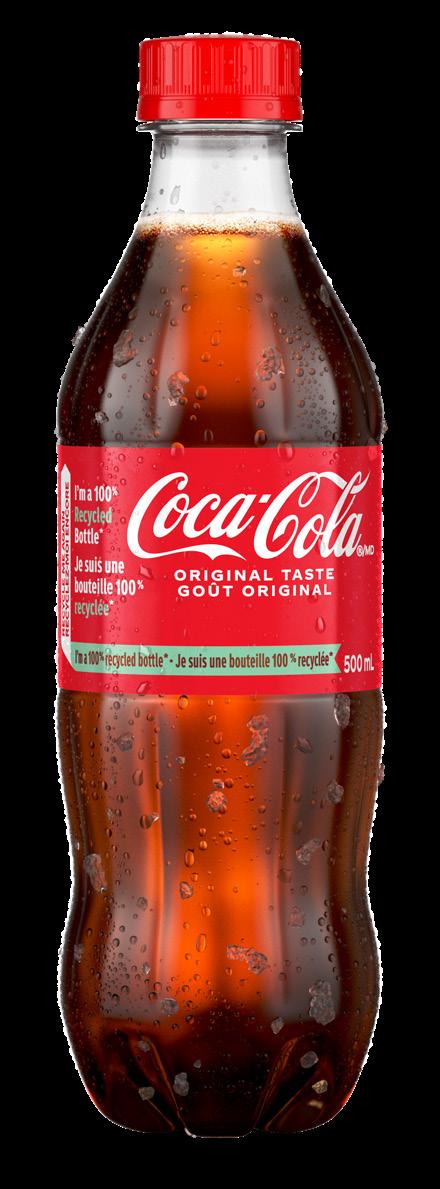
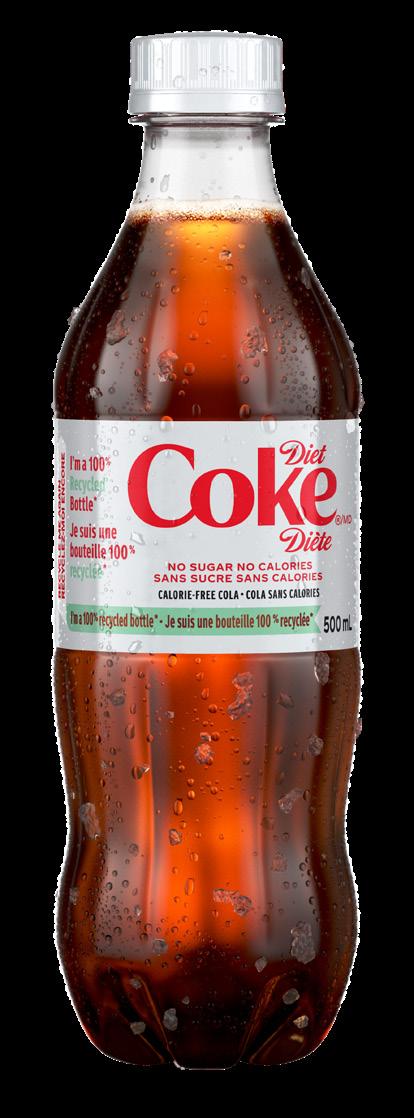
*Excludes cap and label. The trademarks that appear are the property of their respective trademark owners.
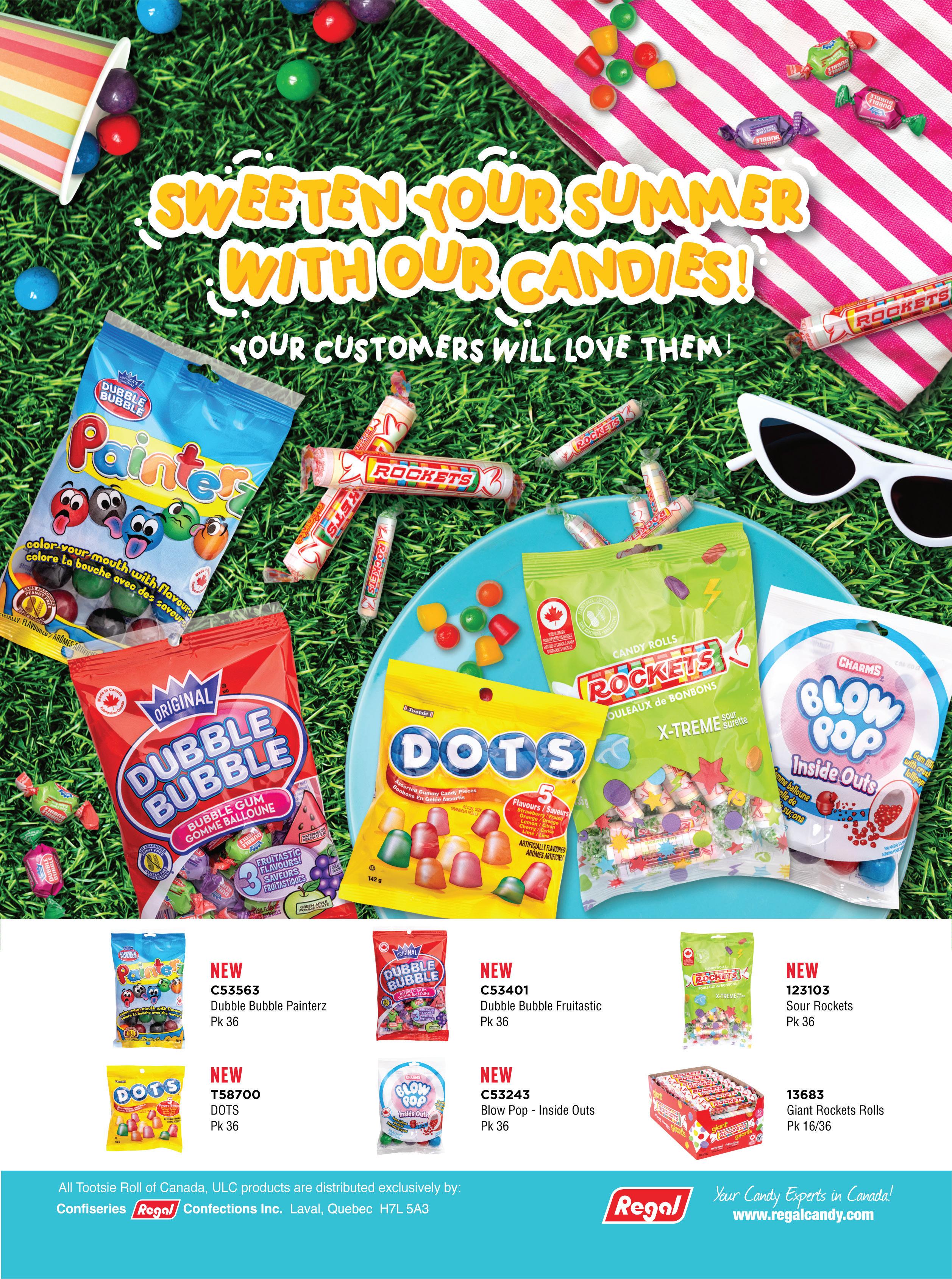

Today’s c-stores are a destination for an ever-increasing assortment of innovative dairy products targeting busy, health-conscious consumers
BY WENDY HELFENBAUM
While convenience stores used to be a late-night destination to grab a litre of milk, they’re now also a hive of innovation, as dairy suppliers launch award-winning products—from flavoured milks to plant-based products, drinkable yogurt and grab-and-go healthier-for-you snack items.
Canadians are constantly looking for innovative, fresh, healthy and delicious products that are easy to find and consume. As the convenience sector evolves, we asked major vendors about what’s flying off the shelves, and what retailers can expect moving forward.
To meet Canadian shoppers’ needs, convenience stores have become a destination for single-serve and take-home packages in different formats, with a longer shelf life that consumers can buy for a competitive price, says Rose Donatelli, director of fluid sales for Lactalis Canada.
“Our job is to make sure we're innovating based on consumer needs and preferences, and industry-wide, we're noticing protein, low-sugar and options that benefit overall well-being are things consumers are looking for,” says Donatelli.
“That's what we've been doing with the c-stores we work with—optimizing the assortment to make sure products are available for consumers when they're visiting. For us, that means high-protein milk items and sports nutrition; and we have plantbased items coming to market in early May.”
With shifting dietary needs, consumer behaviours have evolved, reports Wayne Barker, director sales for Danone Canada.
“While always looking for more convenience in this space, consumers are equally looking for an offering that reflects their everyday dietary preferences, balancing that with the opportunity to try new products on the go before making purchases in traditional grocery channels,” says Barker.
“C-stores are also growing their foodservice, QSR and food programs, which has been huge in changing the perception around c-stores as a food destination with customers.”
As a common household staple, retailers often used milk to drive traffic to their stores, adds Jeff Schnekenburger, national director of foodservice sales for Saputo Dairy Products Canada.
‘Active families and changing demographics in Canada are driving a lot of change in the channel as consumers seek more nutritious on-the-go snacking options’



“Convenience store operators had a ‘set it and forget it’ way of looking at dairy—it was an afterwork or late-night purchase if a household ran out of milk, but today, the convenience channel is focusing more on foodservice and take-home items as well as ‘grab and go’ items, from 4L jugs of milk to single-serve options for both indulgence and healthier options like protein-enriched single-serve,” says Schnekenburger. “Dairy products also play a role outside the cooler door. Important traffic-driving programs like coffee, Slush programs and foodservice items all include dairy products to help drive sales.”
Stocking cooler shelves with enticing offerings keep customers wanting more, and Schneckenburger notes that new flavoured milk in single serve up to 1L jugs is a hit, with the introduction of new fla-

vours adding excitement to Saputo’s existing line.
“Soft-serve ice cream in Slush drinks is also popular, while flavoured coffee creamers and plant-based products are helping with coffee sales in coffee programs,” he reports.
Cheese—perceived by consumers as a healthy snack—is also gaining popularity in the deli sections of c-stores, and Saputo launched Armstrong Combos to capitalize on this growing convenience trend, adds Schneckenburger.
“This product contains cheese and meat sticks in one pack—a perfect fit for the convenience channel,” he says.
Saputo recently launched a 1.89L protein milk in a carton under its Dairyland (Western Canada) and Neilson (Ontario) brands.
“Protein has been a growing consumer trend in dairy that appeals to various demographic groups,” explains Schneckenburger. “We already have bottled protein milkshakes—Milk 2 Go Sport and Milk 2 Go Sport Pro—that do quite well in convenience stores, so having a larger offering in a traditional milk carton seemed to be a natural fit.”
Donatelli notes that Lactalis stays at the forefront of giving consumers what they want, and that strategy is paying off.
“Our number one SKU over the past three years is Beatrice BFIT; it has 34 grams of protein, and it’s in double-digit growth since we launched. The total sports nutrition category is up 64% and BFIT is growing about 80% of those sales—we couldn't have guessed it was going to do as well as it has,” she reports.
“We're always looking for opportunities to innovate and respond to the market, demonstrated by product innovations with less sodium, less sugar, higher protein, and giving consumers healthy alternatives and quick grab-and-go. We're going to continue to find ways to develop that category.”
Barker notes that Danone is seeing an increase in the popularity of existing and new dairy, plantbased and coffee creamer products destined for c-store and QSR channels. “Dairy yogurt drinks and plant-based beverages are increasingly becoming a go-to for customers looking for healthier snacking options. These are not new products, but their increasing availability in the channel are unlocking new opportunities,” he explains.
Active families and changing demographics in Canada are driving a lot of change in the channel as consumers seek more nutritious on-the-go snacking options, Barker adds.
“We’re seeing a very positive response to our So Delicious plantbased single-serve ice cream—it’s a delicious dairy alternative available in several flavours including Salted Caramel and Double Fudge.”
Consumers are continuing to choose food for health reasons and
favouring benefit-led options.
“Protein is the third most important dietary need for Canadians, with four in 10 looking for foods that are a good source of protein; yogurt is one of the top foods those ‘increaser’ households have turned to for protein,” says Barker, adding that interest in probiotics and gut health also continues to grow year over year.
Saputo produced a unique campaign in 2023 where consumers were invited to guess a mystery flavour.
“With single serve being a major category in convenience, Saputo wanted to drive excitement in bottled milk,” explains Schnekenburger.
“New flavours drive trial, and we’re always looking for opportunities to generate consumer interest in the category as well as the brand. Mystery flavour Milk 2 Go added excitement with a national contest to guess the flavour with a $10,000 vacation prize, which was won by a consumer in British Columbia.”
The new flavour—Raspberry Cheesecake—was officially unveiled and is now available for purchase as a limited-edition, he adds.
To raise awareness about new products or upcoming launches, dairy manufacturers are leveraging brand partnerships, adds Barker.
“Our most recent partnership with Tim Hortons has been a major development in bringing plant-based products through our Silk brand to Canadians from coast to coast,” he says. “Our focus is to continuously ensure that we are providing nutritious and delicious options to Canadians who are on the go.”
24_002888_Conv_Store_News_MAY_JUN_CN
Donatelli predicts dairy will head even more towards plant-based offerings, sports nutrition and protein.
“Consumers want to purchase products that are better for them. Giving them an option to make better food choices is important for us as we look to innovation,” she says.
“That's where plant-based fits within our strategy: We’re coming to market with six new SKUs in early May—all will be unsweetened, single nut products in the chilled category, with added protein.”
Foodservice items will be a large focus moving forward in the convenience channel, notes Schnekenburger.
“As convenience stores focus more on traditional quick-serve restaurant items like pizza and sandwiches, dairy manufacturers will need to supply high-quality cheese products for these programs, while still focusing on the important single-serve and take-home components of the convenience channel,” he says, noting that the lines between traditional grocery stores, drugstores, foodservice and convenience continue to blur.
“It’s an exciting time to be a part of the convenience channel community—a collaborative group of professionals working together across the country, from operators to vendors and distributors.
New innovations are always going to be paramount, but what inspires me is that the convenience channel has become a destination shopping experience.”
CSNC


From ice cream novelties to freezies, innovation and premiumization are giving the category a new cool. Insiders share strategies for boosting sales this summer
BY MICHELE SPONAGLEIgnore reports from last year about ice cream sales experiencing a meltdown. Canada is still among the top six ice cream eating nations. Globally, the market for ice cream is expected to expand at a CAGR of 5.93% between 2022 and 2027, according to Technavio. And whether they’re ice creambased or not, frozen treats occupy a unique niche in the market that makes them very desirable to consumers and c-stores alike.
Canadians love affordable, because-Ideserve-it indulgences. Frozen treats tick that box. Innovation and premiumization ensure category sales won’t experience a deep freeze.
“The ice cream category has been growing consistently in recent years,” says Marco Felicella, western sales manager at Chapman’s. “Canadians are certainly eating more ice cream. Consumer demand is ever changing. We must continuously stay innovative and introduce new products to meet demand. Convenience is the place to discover ‘new,’ keeping the category fresh and exciting. The convenience channel wants to lead with exclusive and first-to-market items. This is where innovations debut.”
Chapman’s has been successful highlighting the value and quality of their products. “We provide a perfect mix of both,” he notes. “As inflation continues to be an issue in Canada, Chapman’s can offer quality Canadian products with real ice cream at affordable prices, which is superior to ‘frozen dessert.’ At the same time, consumers are reacting to ‘shrinkflation’ by choosing brands that decide to keep their standard product sizes.”

Ice cream sandwiches and cones are fighting for the first place as Canada’s favourite single serve novelty, says Felicella. Chapman’s dominates in the sales of vanilla ice cream sandwich field, snagging top spot.
New for 2024, Chapman’s has a slew of fresh introductions on deck, including four new, rich luxurious Super Premium Plus SKUs (500 ml) for true ice cream connoisseurs— Cherry Cheesecake, Chocolate Chip Cookie Dough, Chocolate Cake Batter and Ruby Raspberry.
The ice cream category has continued to grow, largely driven by premiumization, according to Paul McMahon, category & shopper development director, Nestlé Ice Cream. “Over the past few years, we’ve observed that consumers are willing to pay more for premium brands that deliver unique and indulgent experiences,” he says.
While classic flavours and varieties will always be big hits with consumers, c-store channels allow for the trial opportunity of those new and different flavours, notes McMahon.
With the launch of two new bars for the convenience channel this year, Häagen-Dazs will expand its single-serve portfolio to include bestsellers from its retail portfolio. Watch for the Häagen-Dazs Chocolate
Hazelnut, featuring velvety chocolate hazelnut ice cream coated in a rich milk chocolate, hazelnut crunch pieces and roasted hazelnuts and Häagen-Dazs exträaz Cookie Dough Dynamo 72 ml, an updated, bigger version of the best-selling bar with a textured coating and 10% more cookie dough.
“As consumers in general look to healthier lifestyles, the ice cream category has participated in these trends with wholesome and permissible options, launching vegan and plant-based alternatives,” says McMahon.
Nestlé’s will expand its portfolio of frozen treats with the introduction of Drumstick Plant-Based Caramel Sundae Cones (120 ml), filled with creamy caramel plant-based frozen dessert, topped with a dark-chocolatey drizzle and crunchy peanuts: It’s first plant-based cone in a single-serve format. The Drumstick brand has been a favourite among Canadians since 1928.
“COVID has taught consumers of the importance of well-being and being proactive in their consumption habits,” he explains. “While indulgence is still the biggest driver, consumers are seeing more options offering a unique approach to health and well-being. The increase in plant-based treats in the frozen category and beyond is an example of this.”
Affordability remains a concern for Canadians as inflation and higher interest rates persist. Retailers can showcase the value proposition of frozen treats by bundling them with foodservice programs, as shoppers also turn to convenience stores for quick, affordable meal deals.
Since ice cream is an impulse buy, the ice cream cabinet needs to be near the cash to provide the highest visibility. He also suggests providing a varied product selection with a range of price points and formats. To support sales, c-stores shouldn’t wait until the first hot day of the summer to stock up on frozen treats. “Maintain a strong inventory position,” he says. “Out of stock means lost sales.”
Meanwhile, Kisko Products is prepared for the summer rush with a sweet product lineup that includes a nostalgic favourite, Mr. Freeze (jumbo and medium sizes, plus no-sugar-added), Freeze Pops, juice bars from Welch’s, Mott’s, Kisko and Crush Freeze Pops. It will add a shelf-stable package of 12 Kisko Amazin Fruit treats, containing real fruit juice.
Company president Mark Josephs is seeing licensed brands, innovation and flavour trends (especially those highlighting tropical fruit) also driving the frozen treats category.
Kisko and Mr. Freeze freezies are sold at ambient temperature, then frozen by the consumer and/or the retailer. The Mr.
Freeze Jumbo format is typically available at c-stores in the freezer section. These products are popular among consumers who are looking for a treat for themselves and their families—after kids’ sporting events and games, working outside on a warm day, or en route to the cottage, he says. “C-stores are a great place for that impulse purchase.”
David Mah, national sales manager, Mini Melts Ice Cream, is hoping for a long, hot dry summer for the company and its retail partners. While sales in the off-season (especially over Christmas and New Year’s) are increasing, summer is prime time. The company is poised for success by bringing back some beloved flavours—Creamy Orange, Mint Chocolate and Rich Chocolate. Its new multi-million-dollar production facility in Airdrie, Alta., will be fully operational by spring.
It is an interesting time in the frozen treats category, he says: “Manufacturers are adding more diverse and exotic flavour options (mango, green tea) to their products. And there is also a niche category for healthier options such as gluten-free and lactose-free, as well as many vegan/nondairy ice cream. Ice cream from different countries, like Japan and Korea, has also seen some expansion in recent years.”
And, due to environmental concerns, brands have focused on being more sustainable by using eco-friendly packaging to be more responsible corporate citizens.
Aiming to sell more Mini Melts? Mah’s advice for c-store stores is this: “The old real estate adage ‘location, location, location’ couldn’t be more true. From our database, there is a clear difference in sales when a retailer is more strategic in their freezer placement than with those that don’t have a plan.”
Location is key
Frozen treats are Impulse purchases, well positioned near the checkout.
Something for everyone
Stock classics alongside premium and BFY options.
Timing is everything
Don’t wait until summer, frozen treats are evolving into a year-round indulgence.
Bundle up
Consumers are looking for deals, consider promos that combine foodservice offerings with frozen treats.
Take risks
Canadians have evolving taste buds and crave unique flavours–be the destination for a favourite new treat. CSNC


Canada's largest convenience, gas and car wash industry event brought together hundreds of exhibitors and thousands of attendees to discover new products, learn about the big issues and network. Follow the QR code for full coverage and photo gallery.




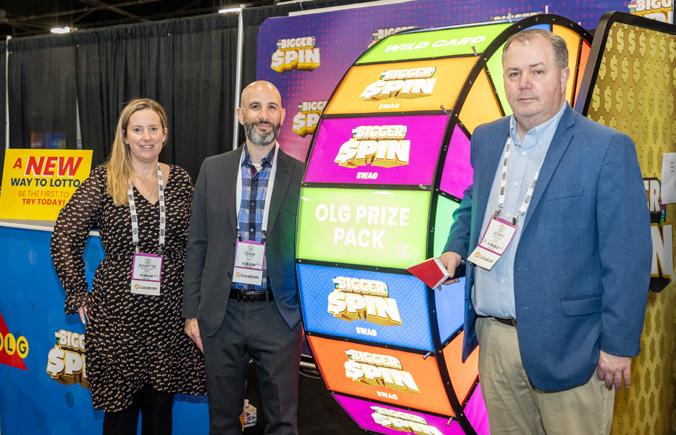











Convenience mainstays, from pop to candy, snacks and lottery, are driving c-store sales, however, purchases of items with heavy competition from other store types, including milk and fresh produce, are waning as people become more price conscious and diversify shopping habits.
The good news is that traditional staples, including chocolate, candy and salty snacks, lead the list of food items purchased
at convenience stores, with a notable yearover-year increase in candy purchases (perhaps evidence of the desire to treat oneself with a small indulgence in tighter economic times), according to the 2024 C-store IQ National Shopper Study.
Now in its fourth year, C-store IQ is the only convenience and gas specific study delving into the ever evolving wants, needs, perspectives and spending habits of con-
sumers. Working with the research team at EnsembleIQ, Convenience Store News Canada surveyed more than 2,000 convenience shoppers 18 years and older across the country (quotas were imposed to ensure measurable base sizes for age generations and provinces or territories) to gauge shopping habits.
C-store shoppers say they spent an average of $17.13 on their most recent visit (excluding the costs of gasoline), marking a decrease from $18.06 last year, but still up from $15.46 the previous year and $13.56 in 2019. Nearly half of shoppers (47%) visit a convenience store at least weekly and plastic continues to be the favourite payment source, while mobile-based alternatives hold steady. Here's a look at what c-store shoppers say they are spending on.
Non-food products purchased at convenience
Non-consumables follow a similar pattern as food and beverage, where core products— lottery tickets and fuel—reflect consistent purchase rates compared to previous years, while items with heavy competition from other store types have dropped.
Convenience stores share of candy/gum and cold/frozen dispensed beverages increased significantly, while general merchandise and health and beauty care dropped. However, specialty/natural and grocery also saw shares drop in most categories, likely due to shoppers tightening budgets.
As expected, due to provincial law, more Quebec shoppers have the ability and do purchase beer/ wine/ cider/coolers from convenience, with 34% doing so compared to 15% of all shoppers. It will be interesting to see how this develops in the coming years.
Non-edible grocery
Health and beauty care
Other tobacco products
Hot dispensed beverages
Packaged beverages
General merchandise
Beer/wine/cider/coolers
Edible grocery
Cigarettes
Candy/gum
Prepared food
Packaged snacks
Cold/frozen dispensed beverages
purchasing
While a convenient location is the most common rationale for shopping more at convenience stores, one-in-10 shoppers highlight convenience offering increasingly better value through pricing than local grocery stores.
Close proximity
Better pricing/more promotions
Fast/saves time
General convenience
Longer hours of operation 24/7
Purchase gas /driving more
Variety/selection
Easier to shop
Purchasing more in general
No reason, just shopping more
Satisfy craving/for treats
Cigarettes/smoking more
Why would you like to see beer/wine/cider be available at convenience stores?
The benefit of one-stop shopping is a reason that over half of shoppers think beer/wine/cider/coolers should be offered at c-stores.
Convenience (one stop shop)
Close proximity to home
Faster service and less wait time Better prices Better variety
Those opposed to beverage alcohol at c-stores cite sufficient availability, no interest in purchasing, accessibility to minors and general safety concerns. Old habits die hard, with 61% of boomers and gen X saying there are enough alcohol outlets (compared to 34% of millennials and gen Z). However, 13% of younger shoppers cite religious concerns, compared to 6% of younger shoppers.
Enough alcohol outlets already available
Not a priority (do not care/do not drink)
Easy accessiblity to minors/not family friendly Safety concerns
Specialized stores are better Health concerns Religious concerns
Since last year, grocery has expanded its advantage over other store types as the preferred one-stopshop solution for essentials, stealing share from drug and dollar stores. C-stores hold steady and are the preferred choice of 18% of males, compared to 14% of females. There are notable regional differences, with shoppers in Ontario (17%), Quebec (16%) and Atlantic Canada (22%) relying on c-stores vs. Alberta (10%) and B.C. (9%).



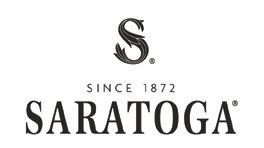










Two-thirds of shoppers indicate a possibility they would switch stores based on sustainability, according to new data from the 2024 C-store IQ National Shopper Study
Convenience Store News Canada asked more than 2,000 c-store shoppers across the country to weigh in on sustainability issues.
As price takes centre stage in the value chain, data shows that 68% of shoppers are likely to switch stores, compared to 74% of shoppers in the 2023 report.
That said, sustainability remains a top priority for c-shoppers coast to coast, who say that donating food, offering recycling containers, local products and working towards zero waste are the most important ways retailers can demonstrate commitment to the planet and its people.
When working to attract the key female consumer, keep in mind that 76% of females value ethical sourcing policies, compared to 69% of male shoppers. How else do they differ?
• Recycling containers for local use: 82% of females vs. 77% of males
• Reusable bag incentives: 76% of females vs. 72% of males
• Donate food instead of throwing it out: 87% of females vs. 79% of males
• Locally sourced products: 82% of females vs. 77% of males
It’s worth noting that there are regional differences in attitudes towards sustainability. For instance, when it comes to eliminating plastic bags/packaging, shoppers in different provinces place a range of value on this action:
• British Columbia (78%)
• Alberta (63%),
• Ontario (71%)
• Quebec (77%)
• Atlantic (70%)
However, across Canada and across the ages, c-store shoppers place a premium on buying local. Shoppers are continuing to buy local at rates comparable to 2023, with two-thirds doing so to demonstrate support for businesses in their communities, a significant increase.
This is especially important to 76% of older shoppers (think boomers and generation X) who say they want to support local businesses, compared to 58% of younger shoppers (millennials and generation Z).
In addition, 79% of shoppers in Atlantic Canada are actively shopping to support local businesses, vs. 62% in Ontario, 67% in Quebec and 63% in B.C. CSNC

Donate food instead of
Reusable
Ethical sourcing policies
Eliminate plastic bags/packaging
Energy-efficient equipment/fixtures


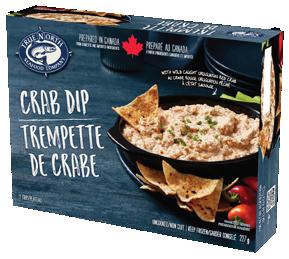







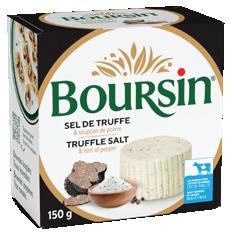


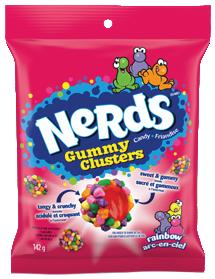



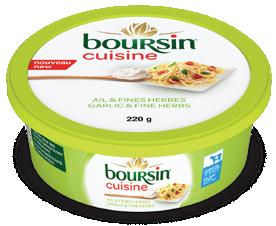









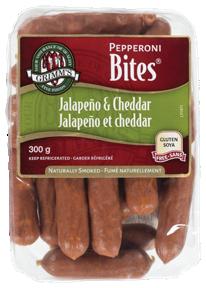















Stop the Shift Show author and former franchise owner, Scott Greenberg, shares insights and strategies for retaining hourly workers and creating winning teams
BY MICHELE SPONAGLEIt’s no secret to convenience-gas operators that managing staff and retaining them is a constant struggle. The concerns are justified. Employee turnover in the convenience store sector is very high, as much as 150% in 2021 according to data. Interviewing, hiring and training staff, most of whom are hourly workers, is time-consuming and many owners are frustrated by the process.
Meet author, keynote speaker and workshop leader Scott Greenberg. As a multi-franchise owner himself for more than a decade, he understands how this is a pain point for many businesses and has shared ideas on how to manage hourly workers smarter in his new book, Stop the Shift Show: Turn Your Struggling Hourly Workers Into a Top-Performing Team
“What I came to appreciate is that hourly workers are quite different than those on salaries, but surprisingly, few resources are available for how to manage them. I took an enormous interest in the topic and thought this book was a great opportunity to address it.”
About 50% of workers in the U.S. and Canada are hourly workers. Gen Z makes up a large, growing percentage and 88% of them are under the age of 25, Greenberg points out. “The way you manage a 47-year-old engineer is not the same way you’d manage an 18-year-old cashier.”
Though it has been easy for some to point to young people as being the source of a high employee turnover problem, Greenberg says not so fast. “I believe in holding people accountable, not just employees but management, too. When I hear that 150% turnover number, that means there's an opportunity for management to improve it by creating more retentive work environments and managing staff more effectively. But most people in management and ownership posi-


tions don't want to take that responsibility. They're busy and think of employment as something transactional. They just want to hire people who are good, instead of growing people to make them better.”
In his research across many business sectors, including quick service, he discovered how some businesses have cracked the code
and have figured out how to hire better, improve retention, and create cultures that encourage people to stay and perform at a higher level. But first management needs to believe in the possibility that it can be done.
The problem, he says, is that managers in certain environments are those who have stuck around longer than others and have demonstrated job competency. “Then they get promoted to management, but that is a
completely different skill set than being a cashier,” Greenberg points out.
And he offers this revealing fact: The average person in a management position manages people for 10 years before they get any formal training to do so. “Companies will spend a fortune on marketing or technology, but they won't invest in this other element that is so critical,” he says. “Instead, they invest all this money by continuously recruiting and continuously fixing problems from under-managed employees.”
It's an issue that is overlooked because there’s a lack of appreciation for good management. Companies believe workers are the problem and not the management, he says, and notes that 60% of employees leave their jobs because of management. People will stay when their emotional needs are being met. There's a greater sense of belonging, a sense of personal growth, respect and personal development.
To retain employees, Greenberg suggests finding out what is important to them and staying up to date as needs change. “I don't look at that as enabling them. I look at it as empowering them and updating your business. One characteristic of Gen Z, for example, is they are highly entrepreneurial. Many aspire to be business owners.”
C-stores can take advantage of that by hiring young people and treating the job as a paid internship. Owners can have occasional conversations with them about marketing, sales and managing the business and other big-picture concepts. That helps an employee connect what they are doing now to longer-term goals. Getting training on something that matters to them helps create a sense of ownership in your business.
It's time to let go of outdated ideas, says Greenberg. While older generations may view suffering as a virtue and may accept being miserable every day to make money, the younger ones recognize that life is short and they aren’t willing to compromise quality of life to earn a living. They expect a healthy work environment. The notion that whatever the boss says goes isn’t reflective of today’s attitudes.
“Employers have to adapt to create more balanced, more human-centric workplaces,” he explains. “I don't want my kids to work for a jerk and be mistreated. I want business owners to show some loyalty and keep
their promises. It’s a war right now to hire employees and those who are going to win the war are ones willing to create a better employee experience. They put an emphasis on the human side of their business. They're not just changing policies and paying people more. They’re deliberate about how their business makes people feel.”
Greenberg encourages business owners to design the culture they want. It’s not just about being nice to people. It’s the positive interaction between team members. He says you need to determine the values that everyone can embrace to make that culture real. He cautions against using abstract concepts. “For every value you think is important, create a list of behaviours—do’s and don’ts—then train employees and hold them accountable,” he advises. “Celebrate wins and identify violations to keep the culture strong.”
C-stores operators can do simple things to nurture culture, like welcoming new employees to the team by hanging a sign with their name, giving them a welcome basket of goodies, or assigning a co-worker mentor for them on their first day. For farewells, you could offer a small gift, a cake or a card signed by fellow employees.
On an ongoing basis, teams may benefit from regular, short group discussions—a chance to go over duties, set goals and reinforce company values. Keep them interactive and have an employee lead the talk. Host social events, like a potluck, and volunteer as a team for a community initiative, to strengthen bonds. Such gestures send a message that everyone is valued.
Greenberg is not a believer in using mission statements and value statements to build culture. “Half the time they are created to impress the public,” says Greenberg. “Take those concepts off the mountaintop and provide guidance for culture that is meaningful for hourly employees.”
Just as managers set benchmarks for sales, they can also establish metrics around employee satisfaction. Survey staff about their feelings about their employer. Ask if they would recommend their job to a friend, rank job satisfaction from one to 10 and allow for open-ended answers to get more feedback. Use baseline scores to make changes, find ways to improve and set benchmarks.
“Make it a priority,” says Greenberg. “You’ll reap the benefit by having engaged employees invested in the success of your business because you’ve invested in them.”
Author Scott Greenberg offers some sage advice on creating dynamic teams.
1. Create a great work experience to build loyalty and to become a best employer of choice. You don’t have to be the highest-paying employer.
2. Offer a good work-life balance, something that gen Z’s value especially. That means being deliberate about scheduling and flexibility.
3. Train everyone who works for you in your company culture, regardless of their job status.
4. Make employee appreciation a ritual.
5. Measure employee satisfaction regularly. Consistently solicit feedback from your team on how to improve the work environment.
6. Teach managers how to lead people, not just the operation.
7. Hire individuals for their mindset and ability to fit into your culture more than for their skill set.
8. Send your employees regular, handwritten notes with praise and recognition.
9. Keep your staff connected to the company and to each other, even if they don’t work together.
10. Provide employees with clear performance standards and measure them closely. CSNC